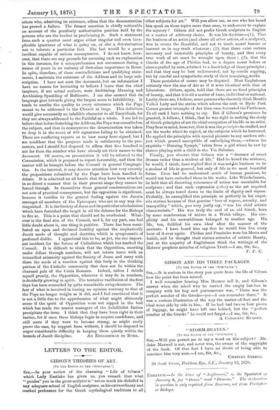[TO THE EDITOR OF THE "SPECTATOR."]
Sin,—In your review of the charming " Life of Gibson" which Lady Eastlake has given us, you remark that what " puzzles" you in the great sculptor is " not so much his disbelief in any adequate school of English sculpture, as his extraordinary and marked preference for the Greek mythological traditions to all other subjects for art." Will you allow me, as one who has heard him speak on these topics more than once, to endeavour to explain the mystery ? Gibson did not prefer Greek sculpture to English as a matter of arbitrary choice. It was his doctrine—(l), That the business of an artist (and above all other artists, of a sculptor), was to create the Beautiful, and not to teach moral lessons or instruct us in any truth whatever ; (2), that there exist certain necessary and immutable principles of beauty, and that every true work of art must be wrought upon them ; (3), that the Greeks of the age of Phidias had, to a degree never before or since equalled by man, attained to a knowledge of those principles ; and that they may be best rediscovered, not by servile copying, but by careful and sympathetic study of their remainingworks.
These postulates of course may be disputed. Most Englishmen certainly view the aim of Art as if it were identical with that of Literature. Others, again, hold that there are no fixed principles of beauty, and that it is all a matter of taste, individual or national. Lastly, there are, I believe, some persons who sincerely think Monti's Veiled Lady and the statue which adorns the arch at Hyde Park Corner greater triumphs of Art than ever decorated the Parthenon. To all such I have nothing to say. But if Gibson's premisses be granted, it follows, I think, that he was right in making the study of Greek principles of art the chief occupation of his life as an artist. Pray bear in mind, however, that it was the principles he studied, and not the works which he copied, or the subjects which he borrowed. He applied the principles with special pleasure to any modern sub- ject which proved susceptible of embodying them,—witness his exquisite " Dancing Nymph," taken from a girl whom he saw by chance playing with a child in the Via Babuino.
Finally, you observe that Gibson was a " dreamer of sweet dreams rather than a student of life." Had he heard the sentence, he would, I think, have replied that it was not,his business to be a student of life in general, but only of life in its most beautiful forms. Even had he understood much of human passions, he would not have embodied them in his works. Like Winckelmann, he held that all distorting vehemence of action was unsuitable for sculpture ; and that such expression (ethos) as the art required must be always toned down to the limits of dignity and repose. Probably, he exemplified this principle so perfectly in his exqui- site statues because of that genuine "love of repose, serenity, and tranquillity" which, you very justly say, " was his chief artistic characteristic." His was truly the soul of an old Greek, born by some anachronism of nature in a Welsh village. His sim- plicity and his unworldliness belonged to another age. His life, too, fulfilled his own ideal after the manner of the ancients. I have heard him say that he would fain live every hour of it over again. Phidias and Praxiteles were his Moses and Isaiah, and he thought their statues miracles of artistic Beauty, just as the majority of Englishmen think the writings of the Hebrew prophets miracles of religious Truth.—I am, Sir, &c., F. P. C.






























 Previous page
Previous page